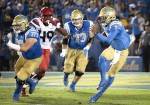Nowadays, it doesn’t take much to be in contention for the Pac-12 South title.
The first-place team has never won the division before, the second-place team’s top two quarterbacks are hurt and the third-place team’s best player by far is injured indefinitely.
Then there’s UCLA, which began the season with its worst start since 1943 but is still in the race thanks to the division’s overall incompetence.
And if coach Chip Kelly wants to repeat the success he had at Oregon, his quarterbacks need to play better.
The Bruins don’t need a Tua Tagovailoa, but they need to do better than ranking 10th in the Pac-12 in pass efficiency and dead last in passing yards per game.
If you rank each of the starting quarterbacks in the conference in terms of his ability to win at full health, neither freshman Dorian Thompson-Robinson nor graduate transfer Wilton Speight would rank in the top half.
The top tier of Pac-12 quarterbacks consists of Oregon’s Justin Herbert, Washington State’s Gardner Minshew and Arizona’s Khalil Tate.
Herbert is widely expected to be the top quarterback chosen in the NFL Draft if he declares this winter – he’s thrown for more than 5,000 career yards and 50 touchdowns, and he led the Ducks to a huge home win over then-No. 7 Washington Huskies on Oct. 13.
Minshew has surprised many by being this year’s premier graduate transfer quarterback in the Pac-12. While he’s playing in Mike Leach’s quarterback-friendly system, Minshew has thrown for at least 319 yards and two touchdowns in every game this season.
As for Tate, you just need to rewatch his game against UCLA last year to know why he’s one of the most electrifying players in college football.
The next stratum of Pac-12 quarterbacks includes Washington’s Jake Browning, Arizona State’s Manny Wilkins, Stanford’s K.J. Costello, Utah’s Tyler Huntley and Colorado’s Steven Montez.
These quarterbacks are each boosted by a standout skill-position player – with a talented wide receiver or running back, they’ll more likely than not find a way to win.
Then there are the signal callers for UCLA, USC, California and Oregon State.
If you transplanted a N’Keal Harry, a Laviska Shenault Jr. or a JJ Arcega-Whiteside to UCLA’s roster, immediately adding a Pac-12 receiver who ranks in the top 50 nationally in receiving yards per game and total receiving touchdowns, Thompson-Robinson or Speight probably won’t take advantage of the mismatches.
Take for example redshirt junior tight end Caleb Wilson, one of the most skilled players at that position in the country.
Wilson had 38 catches for 490 yards last season, including a 200-yard shredding of Texas A&M’s entire defense.
But through the first four games this year, he only had 10 catches for 141 yards and no touchdowns, including an inexplicable three-target, zero-catch game against Fresno State. Wilson’s resurgence the past three games – where he’s recorded 19 catches for 276 yards and a score – has uncoincidentally coincided with UCLA’s three best offensive performances this season.
Wilson knows how to get open and has the equivalent of magnets for hands, so either the Bruin quarterbacks aren’t looking in his direction or they’re throwing uncatchable passes.
To be fair, Thompson-Robinson is still gaining confidence in the pocket and is Kelly’s quarterback for the foreseeable future. He’s going to get better, but his window to win a Pac-12 championship at UCLA is narrow. JT Daniels and the Trojans will always be lurking, and Chris Petersen’s Huskies are a perennial threat in the Pac-12 North.
Kelly calculated at the beginning of the season that he could accelerate Thompson-Robinson’s learning curve by immediately throwing him into action. In three years, we’ll see if it paid off.
